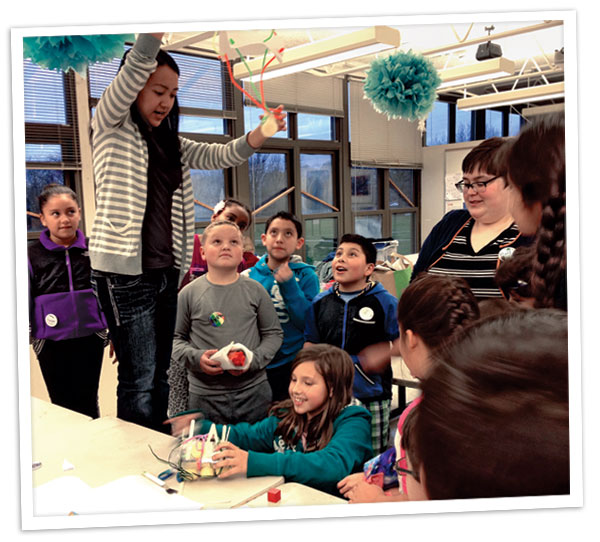MakerBridge Site and Blog Show Diversity in Maker Movement | The Maker Issue

Students in the Michigan Makers program undertake an egg drop challenge
with grad students from the University of Michigan School of Information.
Photo by Kristin Fontichiaro/©2014 Regents of the University of Michigan.
“Diversity matters in the maker movement because of how much making is about empowerment,” says Sharona Ginsberg. “Being a maker is about demystifying the process of creation—learning how to take things apart, put them back together, and create your own. [It] means you have the skills and the knowledge to be less dependent on others.”
These convictions motivated Ginsberg to launch the MakerBridge Project (@makerbridge), a blog and website that highlights diversity. Launched in 2013, MakerBridge describes itself as “a community for anyone interested in the maker movement, especially in libraries and schools.” Regular posts by four key bloggers are interspersed with guest pieces from authors and librarians, tool reviews, tech tips, and more.
Recent posts include “One Expert Is Not Enough: What to Do When Your 3-D Printing Expert Leaves”; “Black History Month and Black Makers”; “Craftism: Activism for Makers”; and “3-D Printer Fails: Avoiding the Landfill.”
Ginsberg, a 2015 Library Journal (LJ) Mover & Shaker, launched MakerBridge while a grad student at the University of Michigan School of Information (UMSI), studying with Kristin Fontichiaro, UMSI clinical assistant professor and coordinator of the school library media program and a 2012 LJ Mover & Shaker. Ginsberg now works as an instructional technology consultant at UMSI, which also hosts the site.
“The type of making that tends to be featured publicly is usually high-tech and oriented toward stereotypically male interests—3-D printers, laser cutters, Arduinos, soldering, robotics, and so on,” Ginsberg says. That focus ignores or downplays “traditional feminine making—sewing, knitting, cooking, crafting, etc.”
Collectively, the MakerBridge team members—Ginsberg, Fontichiaro, Emily Mitchell, webmaster librarian at the State University of New York Oswego’s Penfield Library, and Ayla Stein, metadata librarian at the University of Illinois Urbana-Champaign—bring variety to the site. Some of Fontichiaro’s MakerBridge contributions relate to Michigan Makers, an afterschool initiative in which grad students from UMSI and Eastern Michigan University mentor kids during maker activities in schools, including Mitchell Elementary in Ann Arbor and Ypsilanti Community Middle School.
While MakerBridge initially aspired to be a “library-specific maker portal where librarians could come together and share best practices and their experiences,” Ginsberg says, she sees much greater potential. She wants to explore the “idea of local community hubs hosted by MakerBridge”—allowing people to gather resources, contacts, and event information geared to specific cities or regions. “Making and maker spaces, at their heart, are based in the local community.”
RELATED
The job outlook in 2030: Librarians will be in demand
The job outlook in 2030: Librarians will be in demand
ALREADY A SUBSCRIBER? LOG IN
We are currently offering this content for free. Sign up now to activate your personal profile, where you can save articles for future viewing






Add Comment :-
Comment Policy:
Comment should not be empty !!!
Nolan
The website will also serve as a portal for all things convention related, from a countdown clock to information on logistics, credentials, media walkthroughs and housing. No software to buy, no code to learn, all you need is to be a little Internet savvy and know how to click your mouse. Predicting i - Phone 6: Size, features and release date.Posted : Aug 02, 2015 11:12